A Walk Through Kamata: What An “Unsafe Town” Can Teach About Japan

Many foreign visitors are often unaware of the distinct features of the areas in Japan. Kamata, our Thai editor’s former home in Tokyo, is known for being unsafe, yet it is also a very comforting place. Learn about its charms together on a walk with our editor.
Kamata – the First Step into Japan
The name “Kamata” should sound familiar if you’ve ever flown into Haneda Airport. However, it was seldom familiar to international tourists prior to 2010, when Haneda Airport became an international hub.

Kamata is in Ota, the southernmost area of Tokyo. When I first came to Japan in 2008, I didn’t even know where Kamata was; it took over an hour by train to get to from Narita Airport. I’m able to do coverages in Japanese now, but at the time, I couldn’t even understand the announcements inside the train.
Kamata is occasionally regarded as an “unsafe town” because some people have this image of the district. However, having lived there for three and a half years, this town is a comforting place that taught me about Japan.
Take a stroll with me along my walking route through Kamata! Let’s visit Kamata Station, see a riverbed with beautiful cherry blossoms, and enjoy a picturesque view of Mount Fuji.
JR Kamata Station, Bustling with Restaurants

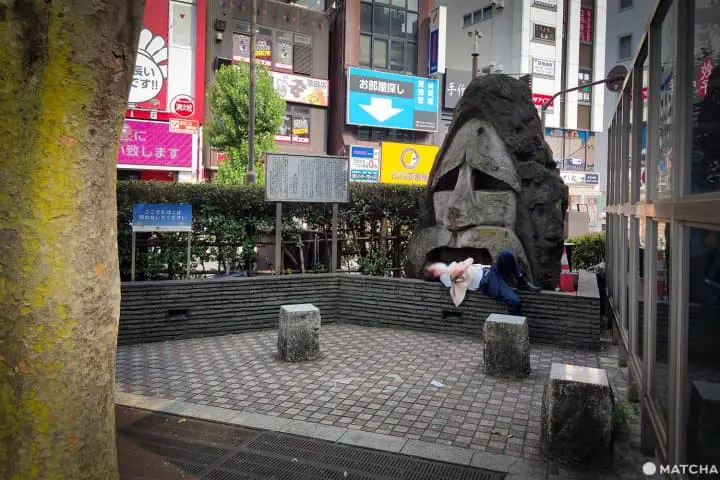
Sleep easy if you want to sleep—that's the Kamata style.
JR Kamata Station has two exits, the East Exit and West Exit. Outside the East Exit is a large traffic circle and smoking area. There’s also a four-meter-tall moai statue!
Cross the traffic circle and you’ll arrive at an area lined with izakayas (Japanese pubs) and restaurants. Walk along the street for about ten minutes and you’ll reach Keikyu-Kamata Station.
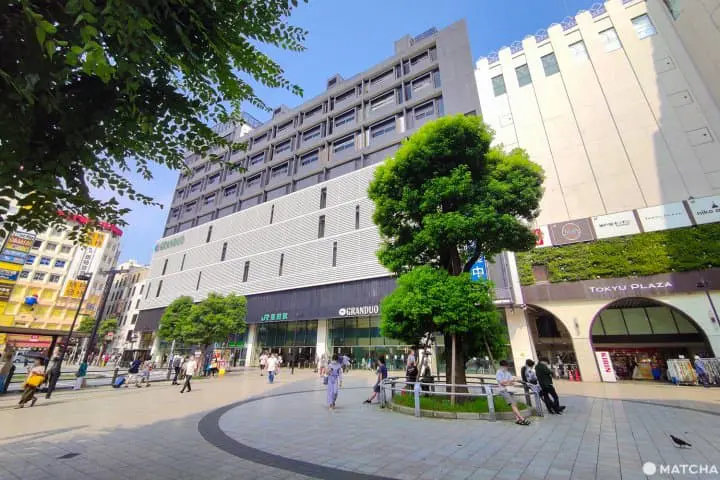
Outside Kamata Station's west exit and station building.
The first place I stepped out of was the West Exit. I remember being surprised, and thinking “I know I left the station, so why am I still in the building?”
The West Exit is inside of the station building itself. Exit out of the station building and you’ll finally be outside.
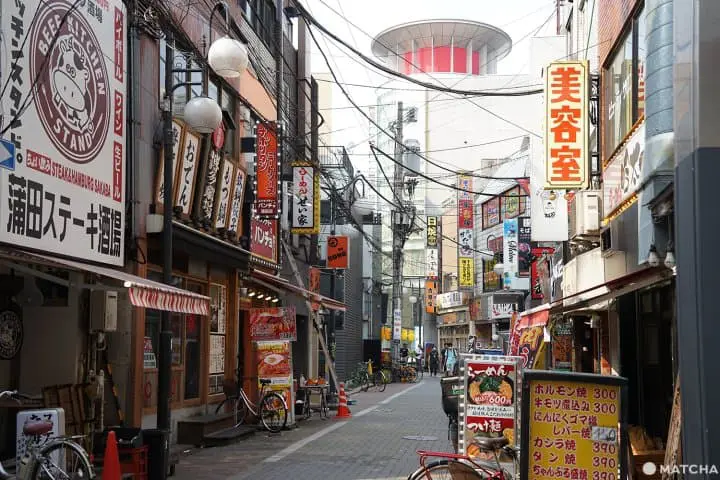
Go down the road to your right, away the station, and you’ll find a number of restaurants. Kamata is a college town, so restaurant prices are also not that expensive.
Looking at the perfectly placed shop signs and bicycles made me think of my hometown in Thailand, but all the signs are in Japanese! At the time, this seemed so incredible.
Reminiscing about my “Firsts” in Kamata
Seiya’s Iekei Ramen – the First Dish that Moved Me
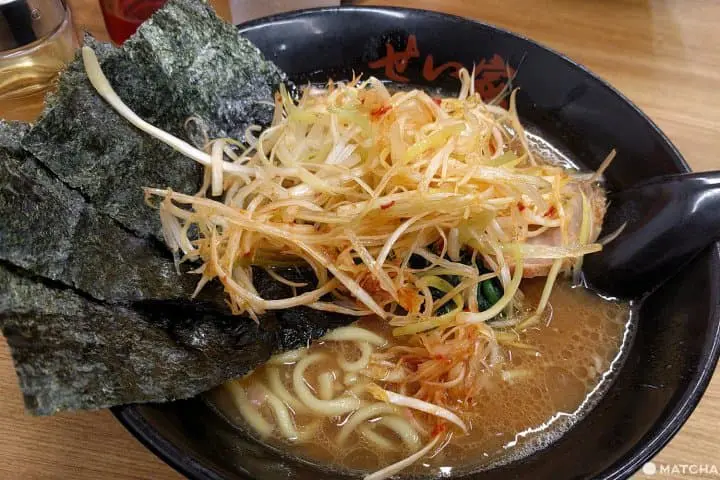
Negi Ramen topped with thinly sliced shiraga negi (the white of green onions)
Let’s eat before we walk! Seiya is where I first tried iekei ramen (*1). Tonkotsu shoyu, a combination of pork bone broth and soy sauce, has such a rich aroma and flavor that it feels as if you’re sucking on an entire pork bone. Its far more flavorful than typical miso or shoyu ramen. A standard ramen is just 500 yen before tax!
Take a look at the official website to find their locations in Kamata.
*1 Iekei Ramen: a ramen characterized by thick, straight noodles in a tonkotsu shoyu-based broth.
Finding the First Shopping District with it All

The entrance to Sunrise, a shopping district, and the promenade decorated with its namesake.
In front of the station is a shopping district called Sunrise. It feels like many names in Japan related to the sun. This could be tied to Japanese mythology, which ties Japan's emperor to Amaterasu Omikami, the sun goddess.
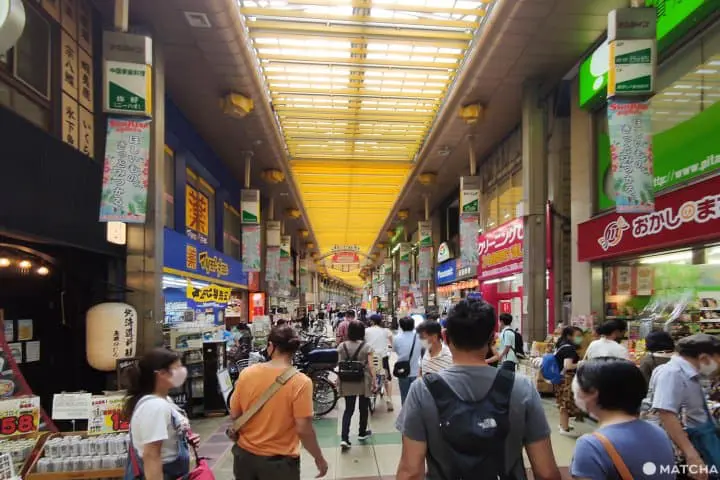
Sunrise shopping district is a street with a collection of small shops. There is a rich variety of cafés, bookstores, drugstores, clinics, clothing stores, and 100-yen shops. Anything and everything you want can be found right here.
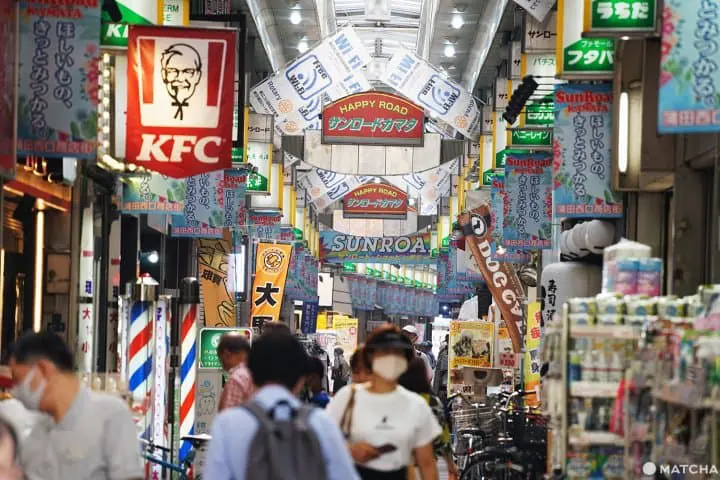
Sun Road, another shopping district, is located parallel to Sunrise. It's a little narrower than Sunrise, but it’s still chock full of stores.
There’s something you should definitely try when you go to Sun Road: hanetsuki gyoza.
My First Hanetsuki Gyoza

From left to right are the gyoza from Kangei (Hoanyon), Nihao, and Konparu
The hanetsuki gyoza (winged pot stickers) from the three Chinese restaurants pictured above are a Kamata specialty. The restaurants are known collectively as the “Big Three Hanetsuki Gyoza” and are the origin of hanetsuki gyoza in Kamata!
Kangei (Hoanyon) is known for their crispy, thin wings. The aroma of ginger and garlic chives mixed into the filling is the best.
The gyoza wings served at Nihao are beautifully fried into a quadrilateral shape. It’s almost so beautiful that you’ll hesitate to separate them. They opt not to use garlic.
The last shop is Konparu. Chopped napa cabbage is used in the filling, then placed inside a thick, springy dough. It’s incredibly juicy.
By the way, the owners of the three restaurants are siblings. It makes you want to visit, and compare them yourself!
Burning Off the Calories with a Walk
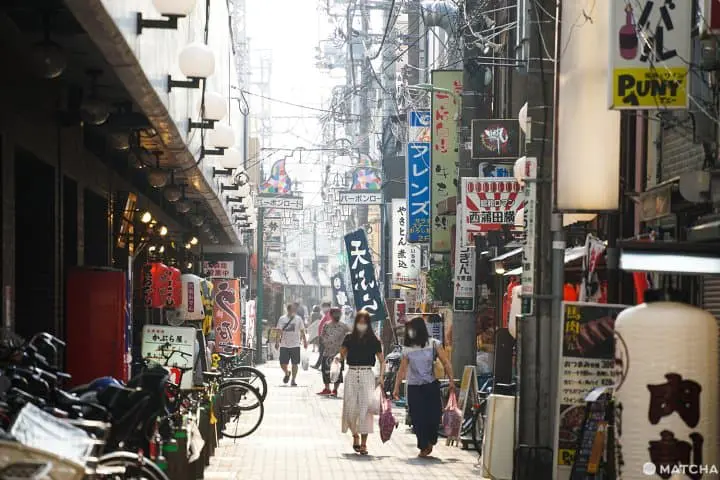
Exit Sun Road and walk on Bourbon Road, a street along the railway tracks. Both sides of this narrow alley are lined with izakayas, bars, and yakitori (skewered meat) shops that bring the streets alive at night.
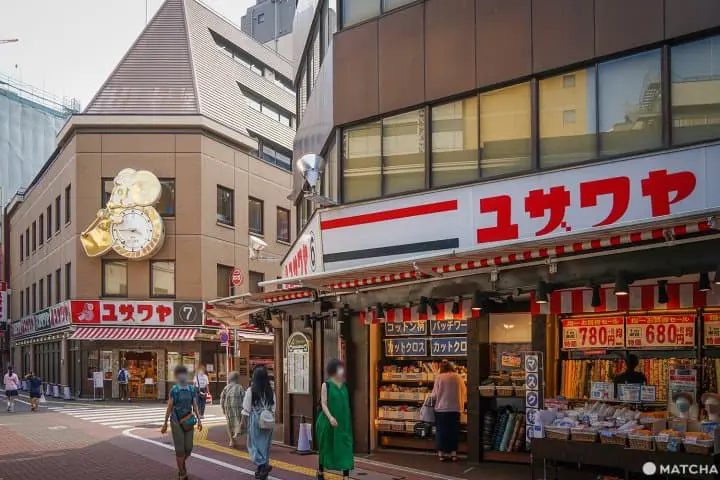
Pass under the railway tracks, then walk a little further and you’ll see a building with the sign pictured above. Yuzawaya is a popular stop for handicraft lovers. It has a collection of fabrics, embroidery tools, sewing machines, leather craft tools, stationery, and various art supplies.
I always bought watercolors, acrylics, clay, woodblocks, and paintbrushes here when I was attending vocational school.
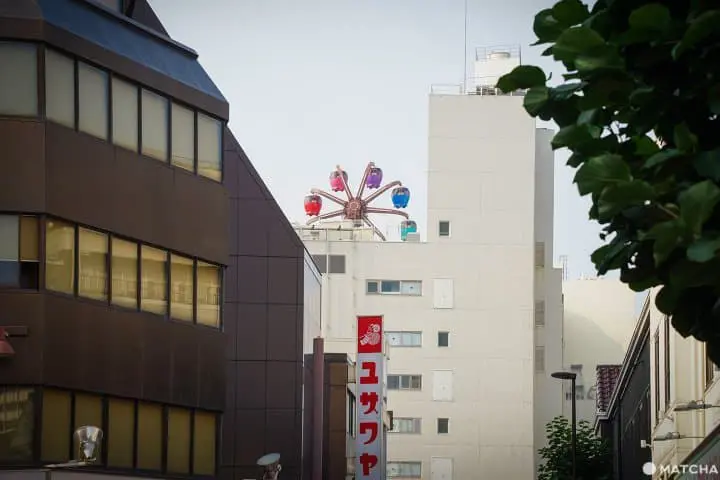
Take a look behind the store. You’ll discover a colorful Ferris wheel on the rooftop of the building. This is Kamataen, the only rooftop amusement park in Tokyo.
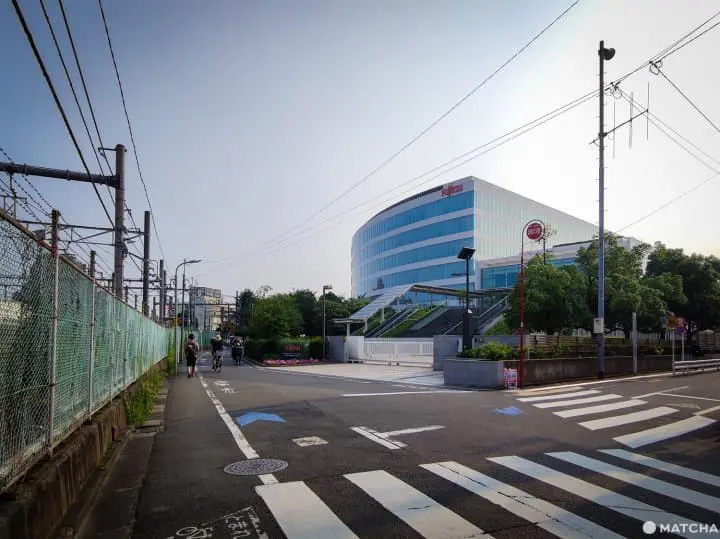
There’s also an office building in the area. I have a bit of an embarrassing story about this area.
On a rainy morning, I ended up falling on my backside on my commute to school in front of these large gates! A huge crowd of office workers on the way to work witnessed this. My backside was in so much pain, but it was nothing compared to how embarrassed I was.

People are always coming and going on this road, no matter the time of day or night. There are less shops and noise the farther you are from the station. Only the sound of the train rings through the streets.
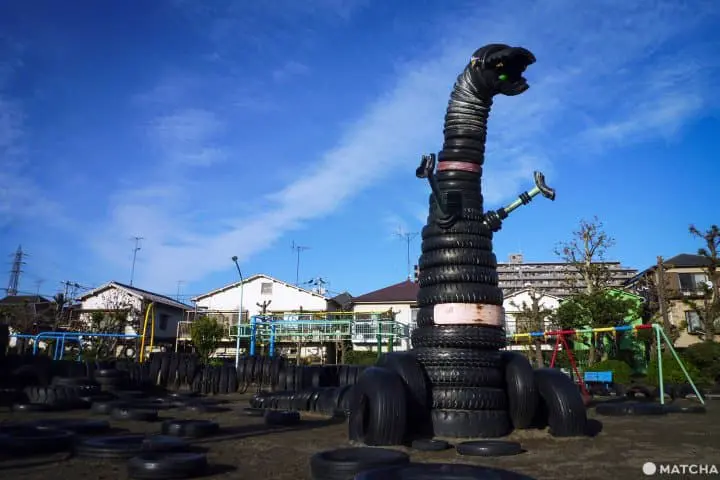
Roar! A large monster appears in the park.
This is Nishi-Rokugo Park. It’s nicknamed Tire Park because of the many tires placed around the park.
Along with the Godzilla-like monster pictured above, there’s also a smaller monster, rocket, and robot. During the evenings and holidays, the park bustles with parents and children who come to play.

Children on the way home from school, waving from the pedestrian bridge. As if in response to the children, the two trains traveling below them sounded their horns.
My First Ice Cream Vending Machine

Next to the stairs to the pedestrian bridge is an ice cream vending machine. It was my first time seeing a vending machine sell ice cream. This very machine was also where I bought my first ice cream in Japan.

I love the mural decorating the guard rails. Look at the rails from the side, and a painting of fish will emerge!

A peaceful tree tunnel spanning across a narrow path. I didn’t ride bicycles often in Thailand, but immediately improved after I came to Japan. It must be because I was traveling through narrow paths like this every day.
To the Nature-Rich Riverbed

Travel about 15 minutes by bicycle, going southwest from Kamata station, and you’ll find a spacious riverbed. I often visited this spot for cycling whenever I found the time.

The nearest station is Rokugodote Station on the Keikyu Line. Cross the road, then walk slightly to the left and there’ll be a road that turns right.

Go up the bank and a vast riverbed will stretch on forever. This area is a multipurpose space that is home to a baseball field, golf course, and even a soccer field. It can be used by anyone as long as you contact the park office. I often saw baseball teams playing matches here on the weekends.
Flowing on the other side of the riverbed is Tama River, which runs through Yamanashi, Tokyo, and Kanagawa. The long slope is an embankment originally meant to prevent the river from flooding.
My First Experience on a Cherry Tree Lined Path

A cherry blossom tree-lined path stretches out behind the embankment. Every spring, the blossoms change into a pretty pastel pink color.
To be honest, I didn’t feel anything special about cherry blossoms before I came to Japan. But the first time I witnessed this scenery in person, I finally understood its charm. Now, I feel refreshed whenever I see the cherry blossoms in full bloom.
My First View of a “Distant Mount Fuji”

On clear days, Mount Fuji can also be seen from here. The mountain itself is far away, so what you’ll see will appear like a silhouette.

Beauty grows as the evening approaches. The position of the sunset changes throughout the year, so you'll never be bored of watching it. There are inspiring skylines no matter where you turn when you live in the city. I felt like I had the most glamorous life being able to admire something as beautiful as this sight every day.
Kamata – A Small Town Filled with Memories

There’s a Japanese saying that goes “home is where you make it.” Simply put, the longer you live in a place, the more you’ll think of it as home. Kamata was truly a home I made for myself.
Difficult Japanese language, an unfamiliar culture and customs, and a new town that some people deemed to be “unsafe.” Nevertheless, during the time I lived there, it became a place where I could be myself and breathe easier every time I returned.
Though I now live in a different town, the Japan I think of will always be Kamata, where lively and calm atmospheres coexist.









































![[Wakayama Guide] Ume and Umeshu (Plum and Plum Wine)](https://resources.matcha-jp.com/resize/720x2000/2025/12/08-252248.webp)
![[2025 Update] From Kansai Airport to Namba - Recommended for travelers with large luggage! Travel comfortably by bus](https://resources.matcha-jp.com/resize/720x2000/2025/10/25-248088.webp)
![[ Naruto City, Tokushima Prefecture ] Experience the world's largest whirlpools up close on a sightseeing boat at the Spring Whirlpool Festival!](https://resources.matcha-jp.com/resize/720x2000/2025/02/05-222727.webp)

![Deep dive into Japanese brands! A tour of famous leather shoe stores with GENSEI & Nin [Madras Edition]](https://resources.matcha-jp.com/resize/720x2000/2025/12/17-253129.webp)